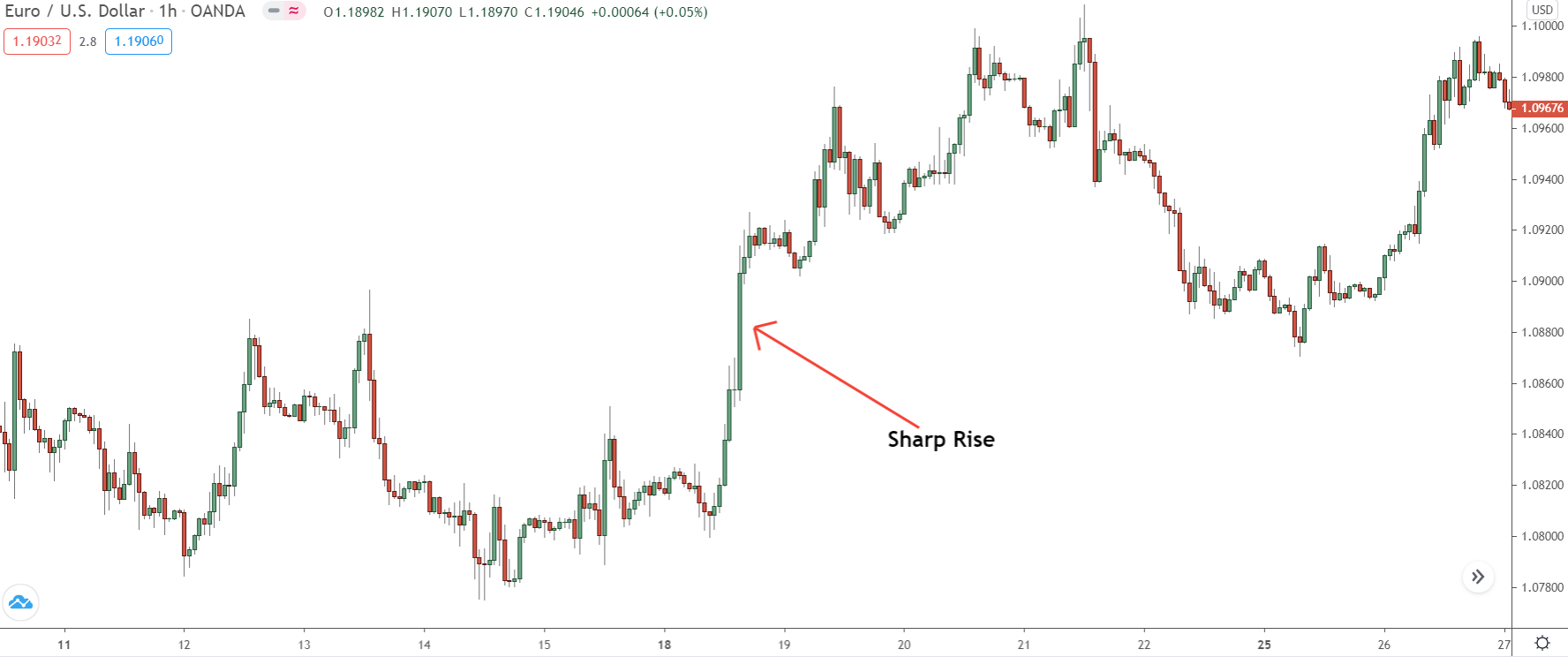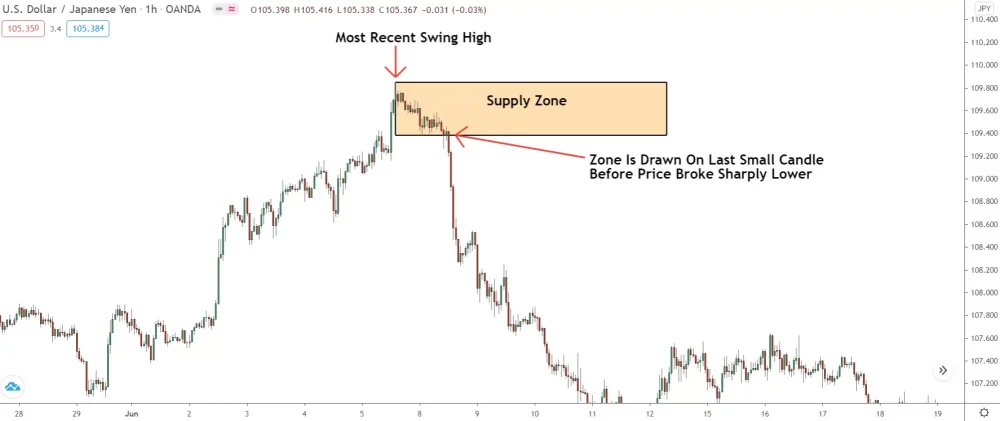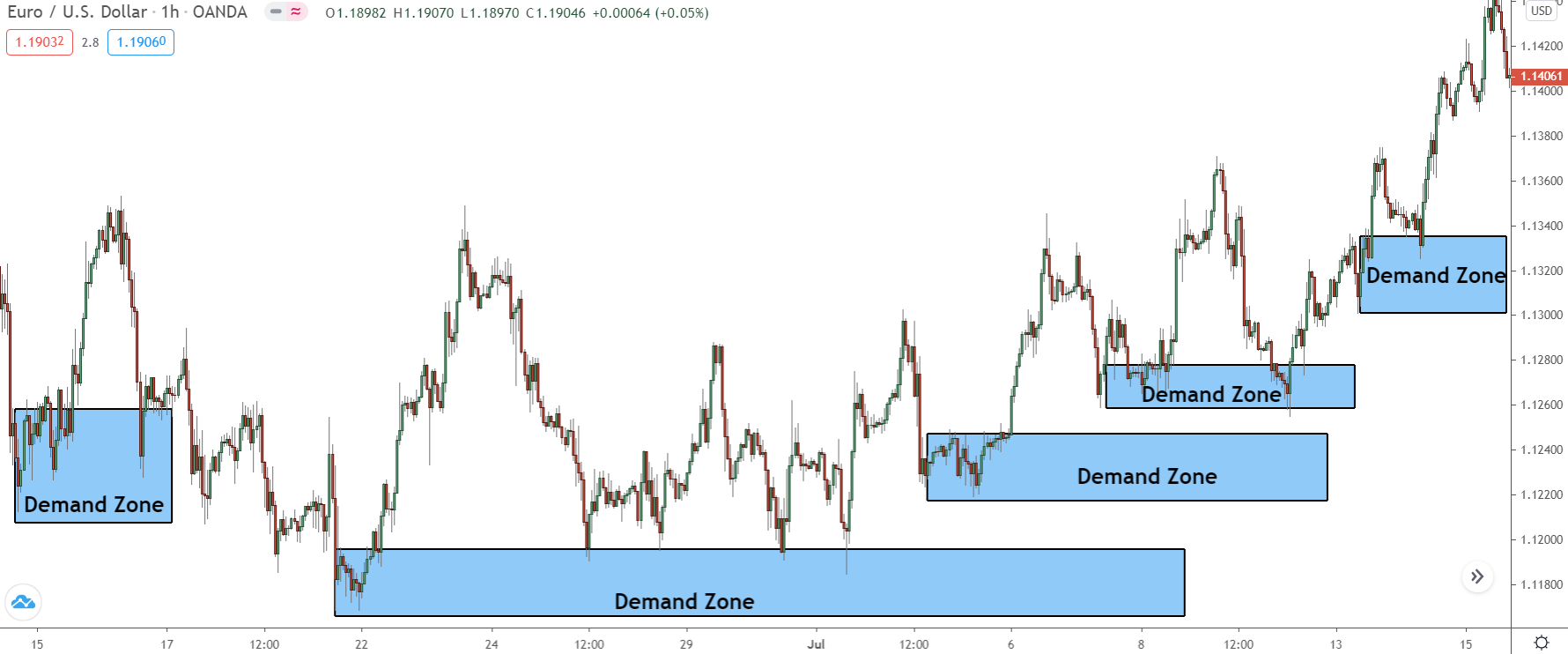Remember that Econ 101 class back in school?
(The one about supply and demand?)
Yeah, me neither. 😴
But here’s the thing…
Supply and demand actually matters A LOT in trading.
By identifying reversals from recent surges of buying (demand) or selling (supply), you can position yourself to capitalize on future reversals from the same price area. This is called supply and demand trading, and I’m here to walk you through exactly how it works and how you can apply it in the markets.
Let’s get started…
- Part 1: Supply And Demand Trading Explained
- How To Identify/Draw Supply & Demand Zones with SupdemV2 (Download Below!)
- Zone-In: The Art of Drawing Supply and Demand Zones (Manually!)
- Trading Supply and Demand Zones: (Entry, Stop Loss, Take Profit!)
- 3 Real-World Examples of Supply & Demand Analysis in Action
- Trade Like a Pro: 3 Must-Know Rules for Supply and Demand
- You're Almost Ready to Trade S&D… (But Not Quite Yet!)
Part 1: Supply And Demand Trading Explained
In economics, the law of supply and demand dictates how much people are willing to pay for something.
This law states:
When supply of a product is high and the demand is low, prices must fall to incite buyer’s interest; when the demand for a product is high and supply is low, prices must rise to represent the scarcity of that product.
Makes sense, right?
Now Forex, along with every other financial market – stocks, commodities, crypto, – is driven by the exact same forces of supply and demand.
News events, economic announcements, even just the general mood/sentiment of the market… all of these factors influence different groups of traders to buy and sell. This constant push and pull creates shifts in the supply and demand balance.

Price goes up? Demand is winning the tug-of-war against supply.
Price goes down? Supply is overpowering demand.
Price moving sideways? Supply and demand are balanced.

The process of supply exceeding demand and vice versa is a “play-by-play” commentary that happens every day, week, month, quarter, year, etc., across all markets.
Supply And Demand: Understanding The Zones
Let’s go over the two zones now, so you can see how they work.
Demand Zones
Demand Zones represent points where smart money exectued a significant number of buy positions.
Think of these as the support levels of supply and demand trading.

Demand Zones form when smart money place a large number, or size, of buy trades. This creates excess demand, and results in price reversing according to two main factors:
1) Bearish Market Sentiment: The more bearish the market appeared before the demand zone developed, the more buying power needed to reverse the current trend. Substantial demand (smart money buying) has to enter the market to reverse the downtrend from the current sellers.
How else could a sizable downtrend just suddenly reverse and price jump higher?
Who’s buying around the lows and selling to create highs?
Hint: It’s not your neighbor, your coworker, or that random guy you met at the coffee shop.
2) Swing Length, Candle Size: Check for 3 or more large bearish candlesticks showing a significant decline prior to the demand zones formation. The more traders selling (supply), the higher the demand (buying) it takes to reverse price. The most recent sizable downswing should also show a clear directional bias; smart money can only execute buy postions during peak selling.
Use these factors as guidelines for gauging (and ranking!) the strength of potential demand zones.
Supply Zones
On the other side of the fence, supply zones.
Supply zones form when smart money decide to sell (supply) a large amount of currency. Excess selling causes prices to fall, leaving behind a zone of supply for future price reversals.
These are the resistance levels of S&D trading.

See how price moves into the supply zone before quickly reversing? And how a bearish pin bar pattern forms inside – that’s your entry signal!
1) Bullish Market Sentiment: The more bullish price appeared before the supply zone formed, the more selling (supply) was needed to reverse the price direction. Smart money selling had to enter the market to reverse the prior uptrend, which was rapidly gaining strength – four bullish candlesticks showing a +0.8% increase for the day is extreamly rare.
2) Swing Length, Candle Size: Look for multiple (at least 3) bullish candles showing a clear rise. The previous upswing should also show a clear bullish directional bias; smart money can only execute sell trades (supply) at times of peak demand – i.e., when market sentiment appears super bullish with most traders buying!
Use these factors as guidelines for gauging (and ranking!) the strength of potential demand zones.
How To Identify/Draw Supply & Demand Zones with SupdemV2 (Download Below!)
You’ve got to nail finding high-probability zones and drawing them like a pro on your charts! It takes weeks or even months of time, practice, and experience, to get this down.
Or, at least, it did…
Check it out… SupdemV2! (SD indicator)
This simple supply and demand indicator for MT4 might be a bit old-school (I’ve had it for almost a decade now!), but it still outperforms most newer SD indicators, and blows many of them out the water for zone accuracy. SupdemV2 is quick to setup, easy to use, and most importantly: Pinpoints laser-accurate SD zones without any human input.

SupdemV2 auto marked these 1-hour supply & demand zones on Usd/Jpy (… from default settings, too!)

Check out a few of SupdemV2’s main settings… adjust these as you wish. (Or just copy mine)

The indicator also comes with Zone Alerts: Recieve a Pop-Up whenever price touches a zone!
Download SupdemV2 below (FREE!) …

Pro Tip: Once you’ve placed Supdem.ex4 file in your “Indicators” folder, you’re good to go! Open the indicator from the menu, keep the default settings as they are, and you should see any recent supply and demand zones appear on your charts.
If you’re not seeing any zones, double-check Supdem.ex4 is inside the MQL4 > Indicators Folder.
Zone-In: The Art of Drawing Supply and Demand Zones (Manually!)
Supdem V2 makes identifying high probability supply and demand zones a breeze, but while the indicator certainly makes life easier, some sneaky zones can (and will) still slip through the cracks.
The Solution?
Roll up your sleeves and draw these zones manually.
How to Draw Demand Zones: The Easy Way
To draw a demand zone, find a steep rise where you think a zone has formed.

1) Identify The Base: Look for a strong rally, marked by several large bullish candlesticks.
The area just before that rally took off? That’s your “base.” This segment of price action represents where smart money entering buy positions, creating the demand fueling the upward move. It’s the foundation of your demand zone and the main focus area for capturing bullish reversals.
Supply & Demand zones can develop a single candle or a consolidation structure, as seen in the image above.
2) Find The Base Candle: The candlestick that kicks off the rally is your base candle.
It’s the last little candle before demand took over and sent prices higher. The base candle marks the final opportunity smart money had to execute buy orders, making it the upper boundary (proximal line) of the demand zone.
The base candlestick can be bullish or bearish!

3) Draw The Zone From The Base Candle: The base candle marks where buying pressure finally overwhelmed selling pressure. Mark the upper demand zone edge (proximal line) from the base candle down to the lowest swing low under the base.
4) Drag The Zone Down To The Lowest (Recent) Swing Low: The lowest swing low represents the end of the demand zone (distal line). It’s the inital point where smart money buyers stepped in and consumed current sellers, reversing the prior short term downtrend.

5) Success – Check Your Demand Zone: The area between the base candle and the lowest swing low under the base is your demand zone.
The zone visually represents where significant buying interest (from smart money or other traders) entered the market. Each smaller low within the zone is a potential point where SM demand stepped in, contributing to the demand zone’s formation and eventual rally.
Remember: The demand zone may attract smart money buying interest in the future, making it a key area to watch for potential trade opportunities.
Next Step? Watch for Price Retests: Demand zones become important when price approaches them again; the sooner it returns, the higher the odds of a successful reversal. Use Pin Bars and Engulfing Patterns for a smooth entry into a high R/R long position! Both candlesticks indicate buying pressure exists within the demand zone, further boosting the chance of a reversal.
Pro Tip: Can’t find the right swing low? Just look for the lowest swing low created underneath the base (price action build up before the swift rally. That’s where market sentiment appeared most bearish, and peak sellers existed across all timeframes for smart money to buy against.
How To Draw Supply Zones: Step-By-Step
Drawing supply zones follows the same process as demand zones:

1) Identify The Base: Look for a steep decline consisting of multiple bearish candlesticks. The price action located just above is the supply zone base. Smart money entered sell positions around these candlesticks to start the decline and create the supply zone.
2) Find The Base Candle: The candlestick that starts the decline is the base candle. It’s the last small bullish or bearish candle that formed before price plunged lower.

3) Draw The Zone From The Base Candle: The base candle represents the last possible time smart money entered sell positions to finally overwhelmed demand. Start drawing your supply zone rectangle or line right from this candlestick (you can use either the open or close price).
4) Drag The Zone To The Highest (Recent) Swing High: The swing high marks the upper boundary of your supply zone. It’s the point where smart money overpowered the eager buyers – remember, market sentiment was super bullish before this swing high formed; who sells when everyone’s buying.

5) Success – Check Your Supply Zone: The area between the swing high and base candle is the supply zone. It shows where massive smart money selling came into the market, and pinpoints where further selling may enter in the near future.
Trading Supply and Demand Zones: (Entry, Stop Loss, Take Profit!)
Today, there stands two primary ways of trading supply and demand:
Price Action entry, and Set and Forget entry.
Each entry strategy has pros and cons, and it’s possible to make consistent money using either. Zone identification skills matter more trading “Set & Forget” than entering using price action (Pin Bars, Engulfing Patterns), but both strategies offer numerous high R/R trading opportunities.
Hit the tabs below to learn more…
3 Real-World Examples of Supply & Demand Analysis in Action
Explore practical applications of Supply & Demand analysis through real-world trade examples. I’ll revisit some past user trades, breaking down the charts, explaining the right/wrong decision-making process, and highlighting the S&D principles for successful outcomes.
Trade Like a Pro: 3 Must-Know Rules for Supply and Demand
You’ve got the basics of supply and demand down, and you know the two ways to trade zones. You’re practically itching to start putting zone to work, right?
Hold your horses… just a second!
Before you dive in, check out these three key rules…
You’re Almost Ready to Trade S&D… (But Not Quite Yet!)
You’ve got the basics of supply and demand down, and you know the two ways to trade zones. You’re practically itching to start putting zones to work, right?
Hold your horses… just a second!
There’s way too much to cover about S&D in just one post.
So, I’ve put together a collection of important lessons right here to help explain the finer details of supply and demand.
Oh, and one more thing: Check out my new SD FAQ’s database, featuring detailed emails from supply and demand traders just like you: Take a look, and if you still have questions, feel free to leave me a comment!
3 Key Facts Sam Seiden Gets Wrong About Trading Supply & Demand

Sam Seiden popularized Supply & Demand trading, but some of his ideas clash with market realities. In this post, I’ll break down the 3 biggest issues and why they don’t add up.
Why You Should Avoid RBR/DBD zones over RBD/DBR zones

Supply and Demand zones come in two flavours according to how and why they develop. This article explains the key differences between them, and why the most common type (RBR/DBD zones) struggles to outperform their RBD/DBR counterparts.
Supply/Demand Zone Types: Profit Taking Zones Vs Trade Execution Zones

SD zones can develop from smart money placing trades or taking profits. Knowing the origin of a zone can give you a serious edge in your trading. It helps you understand the underlying market and anticipate how price might react when it revisits that zone.
Don’t Make This Mistake Drawing Supply/Demand Zones!

Drawing supply and demand zones correctly is the most important skill in SD trading, but many traders make a simple mistake that ruins their zones and causes losses. This article explain how to avoid this mistake to draw zones correctly.
Thanks for reading,
PAN























so. for the entry signal
we should go down to lower timeframe to find or just stay the current timeframe we trade at
Hey Marvin,
Stick with the timeframe you trade off for now. You can use a lower time-frame but I need to explain it more, as there are a few things you need to be aware of. I’ll try to get a guide about it out in the next few weeks.
Hey Liam,
this is piece of art. I already read your S/D book and all articles from old web, but this is again eye open in another way. I have again some ideas how to read price.
Thanks
Glad you liked it Lucky.
Got some more S + D posts on the way. Keep a lookout for them over the next couple of weeks.
one more question. what about the profit taking lvl, I am little confused with it
thx
Hey Marvin,
The profit-taking level should be the closest zone on the higher time-frame. So if you trade off the 1 hour, you need to take profits once price reaches the next zone on the daily. If you trade off the 1 min or 5 min, take profits once price reaches the 1-hour zone. Don’t take profits right away, though. Wait for signs of a reversal first, and then take profits if you see something developing.
Great post, you have taught me how to draw supply and demand zones. I have more idea now how to draw these zones.
Great, glad to hear Sbo!
Let me know if you need anything else.
Thanks for your guidance in S&D. you enlighten me of some points as i am trading this method already. appreciating your efforts.
Thank you very much for making me know s/d zone but how do you identify it
No problem, lucky. Happy to help 🙂
Hi great article! I just found about this website and it is really helpful. Do you have any tips about profit-taking strategies you use? Do you take some profit at the first trouble area or do you just wait for it to hit the target? I have been having an issue where I tend exit the trade pretty early so I usually only earn around 2Rs per trade. I feel like you never know if the price is gonna reverse at the first trouble area. Did you ever has this issue when you were learning?
Like!! I blog frequently and I really thank you for your content. The article has truly peaked my interest.
Hello,
Can you please explain more about the curve? I trade the daily time frame and using H1 for confirmation when the price reaches the daily zone.
Hey Mandala, Liam here.
To be honest, I don’t really use the curve concept in my trading. I understand it is a part of supply and demand theory – the economic concept of S & D, I mean – but for trading, I just don’t think it adds anything valuable. It kind of narrows your view of the market and what zones are important, I think.
Much better to just concentrate on figuring out where the strongest zones are – zones created from the banks placing big trades – and then trade off of that, rather than focus on what the overall curve is, which may cause you to put more importance on zones that aren’t that important if that makes sense?
Liam.
quick question. for test demand zone which candle must be appear red or green candle . what if whole candle touch the demand zone without wick on distal line ,does it consider rejection? if i saw demand zone in Day chart , still i have to go small time frame or not. when should i go small time frame ? your expedite reply would be wonderful. thank you
It can be red or green, Roshan, doesn’t matter which. The candle must touch the edge of the zone to signal a rejection, that’s the most important thing. If it doesn’t touch the edge, it’s not classed a proper rejection, just a normal spike. As for daily zones, you can drop down to a lower timeframe if you want, it depends on your preferences really. I like to drop down to lower risk, but you can stay on your normal timeframe too – it’s up to you, really.
Please what is your take on this?
I trade zones if price returns within:
5 min TF = 2 hours of zone creation
15- 30 min TF = 6-8 hours of zone creation
1 Hour TF = 24 hours of zone creation
Daily TF = 1 month of zone creation
Weekly TF = 1 year of zone creation
Try these instead, Steve:
1 min/5 min/15 min – 1 day.
30 min/1 hour/4 hour – 20 days
Daily – 3 months
I’ve tested these myself going back quite a few years, and they seem to work really well. Just give a little leeway with the times; you don’t need to be super specific, e.g if a zone forms 1 day over the daily TF time, that’s still a valid zone. You can’t be exact with things like this, so you have to allow for a little variance with when price should return.
I’m very grateful sir. You’re doing a great job
Hi Liam,
Would like to know if S & D zones could be traded at anytime of the day, i.e. Asian, London & New York market hours. Thank you
Yes, you can trade them at anytime, Steve. The time of day doesn’t matter, only whether the zone is strong or not.
Noted with thanks sir
Hi Liam
thank you for the quality lesson above . your material has proven helpful for me and i change my whole perspective on trading.
please see “How To Trade Supply And Demand On The Daily: Full Guide + What You Need To Know” as the page does not open
thank you
Would Like To Know If You Have Written The Guide On Using The Lower Timeframe To Enter S&D Zone … And the guide on how to trade S&D zone daily
I haven’t got a guide on entering using a lower timeframe zone, Esther – I’ll try to get something out in the near future. I have got a guide on trading S & D on the daily, though…I took it off the site as I’m going to re-purpose it for another post, but I’ll send it over to you so you can read it.
Cheers,
Liam.
Hello PAN,
I have searched your site to see if you have ever written any articles relative to identifying “Fresh” zones of S/D and can’t seem to find any. If you have written information on the subject can you kindly point me in the right direction so that I may read your input?
Additionally, does the daily average range play a role in your strategy?
As mentioned before, I enjoy your site and believe that its content is going to provide hours and hours of reading and hopefully results in my becoming a better trader.
Presently I am demoing and although not consistently profitable I am pretty much B.E. Breaking even isn’t the way I want to go. Studying your material has brought a new understanding of how the market is really set up to make me lose money.
If I can figure out how they plan to do it the better off I’ll be. I purchased your Zero Sum Fun book and it is opening my eyes even further.
Regards,
I don’t have any articles on identifying fresh supply and demand zones… but I’ll try to get something out in the near future.
Got my hands full at the minute!
My Main Strategy: Pinpoint zones around major swing highs and swing lows.
Every swing high or low forms due to the banks either taking major profits off their trades or placing significant trades to cause a market reversal. Price has a much higher probability of reversing at zones formed from these swings compared to zones which form in the middle of moves—(rally-base-rally or drop-base-drop zones).
As for the Average Daily Range (ADR), it’s not a primary tool in my strategy…
I sometimes use it to gauge the potential limits of market movement during a given day.
I’ll try to explain it further in some upcoming articles. The ADR you’ve noticed in my screenshots isn’t the best, as it only displays data for the past 20 days… I really need an ADR with more customization, showing the ADR for the past 5 days, 10 days, and so forth.
Hope this helps,
PAN.
Good afternoon,
I hope all is well with you!
I had last week received my free S & D trading booklet – of which I found very useful!
However, I have 2 questions for you:
1. In order for a Supply or Demand zone to be considered tradeable, does the candle-stick that follows have to fully engulf the one beforehand?
2. Do zones expire once they’ve been hit and ‘used’ once? For example, say price moves into a Supply zone and then begins to move back DOWN out of it. If price then moves back up into this zone, is this zone still considered to be tradable, or would you consider it to be expired?
I have been experimenting lately with a variety of strategies, finding that some work better than others, am interested to see how this one works!
Regards,
Hi Pan,
Thanks for sharing your experience. Sam talks a lot about staying outside of fair value but doesn’t give much away on what rules he uses to identify fair value except for it’s where the majority of trading is taking place. Just wondering what your experience is with fair value and if you consider it at all?
Thanks,
Daniel
Hi,
I find your explanation on the S&D very interesting and it was different from what i have learned. May i know are you still using this S&D to trade currently? Btw, is all course content updated and applicable to current trading environment? What other courses you are teaching other than current courses found on this website?
Regards,
Ben